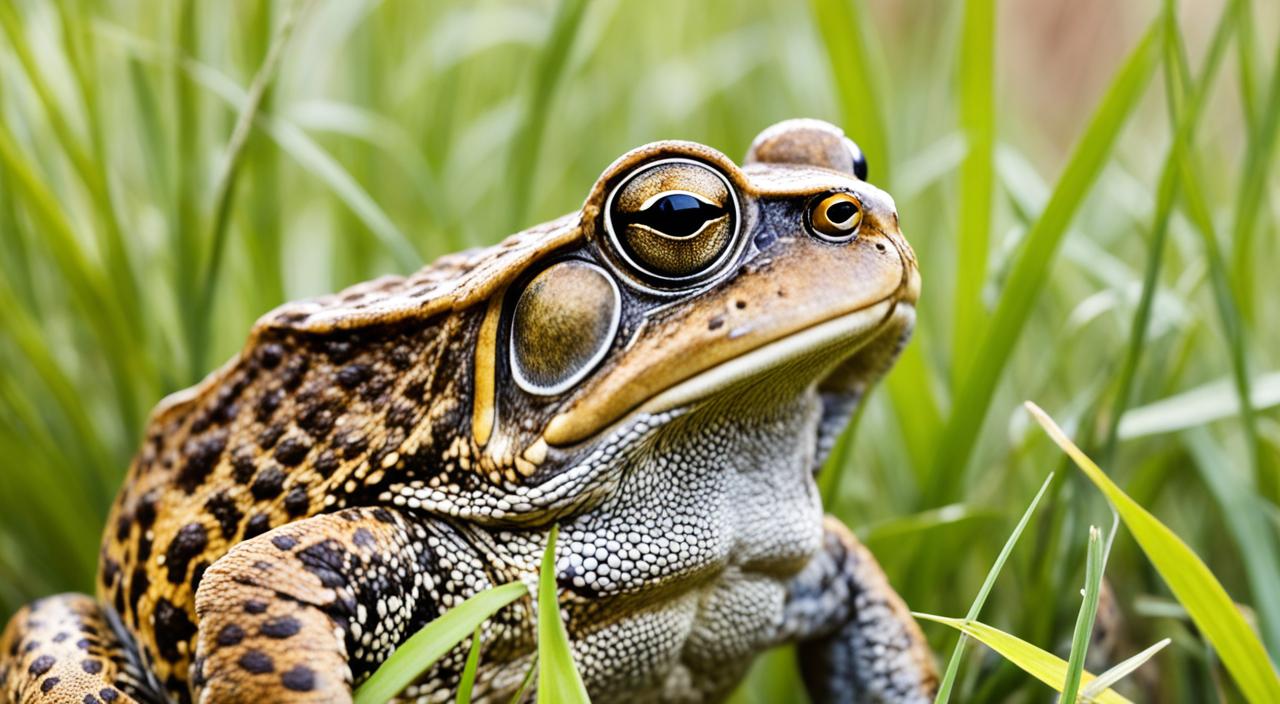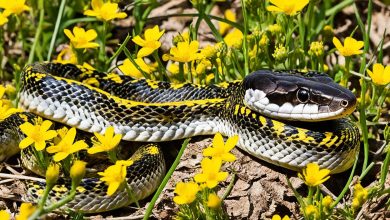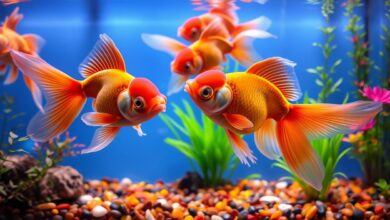I watched a cane toad hop across my backyard lawn. This creature has become a symbol of Australia’s complex relationship with introduced species. The cane toad, or Bufo marinus, has significantly impacted our landscape and wildlife.
Cane toads in Australia show the dangers of unintended consequences. They were brought in 1935 to control agricultural pests. Now, their population has grown from 102 to about 200 million in less than 85 years.
This invasive species now endangers over 2,000 native Australian animals and plants. Their rapid spread threatens the delicate balance of our ecosystems.
Cane toads are tough and breed quickly. A female can lay up to 35,000 eggs twice yearly. They spread across northern Australia at 50km per year.
Their toxic venom is deadly to native predators. This includes goannas, freshwater crocodiles, snakes, and quolls.
Cane toads can reduce local native predator populations by 90% within months. They affect 75 species of Australian lizards, crocodiles, and freshwater turtles. Of these, 16 are considered threatened.
There’s still hope despite these challenges. Researchers and groups like WWF-Australia are working on new solutions. They’re using taste aversion training to help native species avoid cane toads.
Understanding cane toads is key to protecting Australia’s unique biodiversity. Our efforts to manage this species will shape the future of our ecosystems.
Origins and Introduction to Australia
Cane toads hail from South and Central America. In 1935, they were brought to Queensland from Hawaii. This marked the start of a notorious biological control attempt.
Native Habitat
Cane toads thrive in diverse South and Central American ecosystems. Their adaptability to various environments helped their later spread across Australia.
Introduction to Queensland
Australian sugar farmers faced a big problem with cane beetles. To solve this, 102 cane toads were imported for breeding. Later, 2,400 toads were released into Queensland’s sugar cane fields.
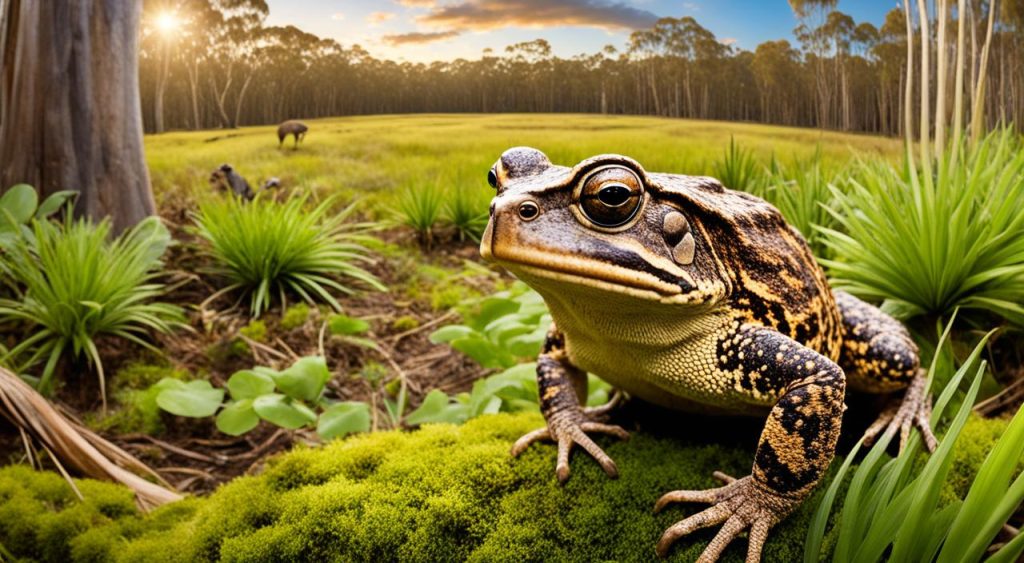
Intended Purpose for Pest Control
Cane toads were brought in as a form of biological control. Sadly, this plan didn’t work out. Cane beetles live high on cane plants, out of the toads’ reach.
Instead of managing pests, the toads caused an ecosystem imbalance. This led to unforeseen problems in Australia’s environment.
| Year | Event | Impact |
|---|---|---|
| 1935 | Introduction to Queensland | Start of cane toad population in Australia |
| 1950 | Declared a problem species | Recognition of negative environmental impact |
| Present | Population over 200 million | Widespread ecosystem disruption |
Physical Characteristics of the Cane Toad
The cane toad, or Bufo marinus, has unique features that make it stand out. These tough creatures have adapted to various environments. They thrive in South America and introduced areas like Australia and Florida.
Size and Weight Range
Cane toads are bigger than many native toad species. Adults usually measure 10-15 cm long, with some reaching 24 cm. Their weight varies from 100g to 1.5 kg.
The largest cane toad ever found was called “Toadzilla”. It weighed an impressive 2.7 kg!
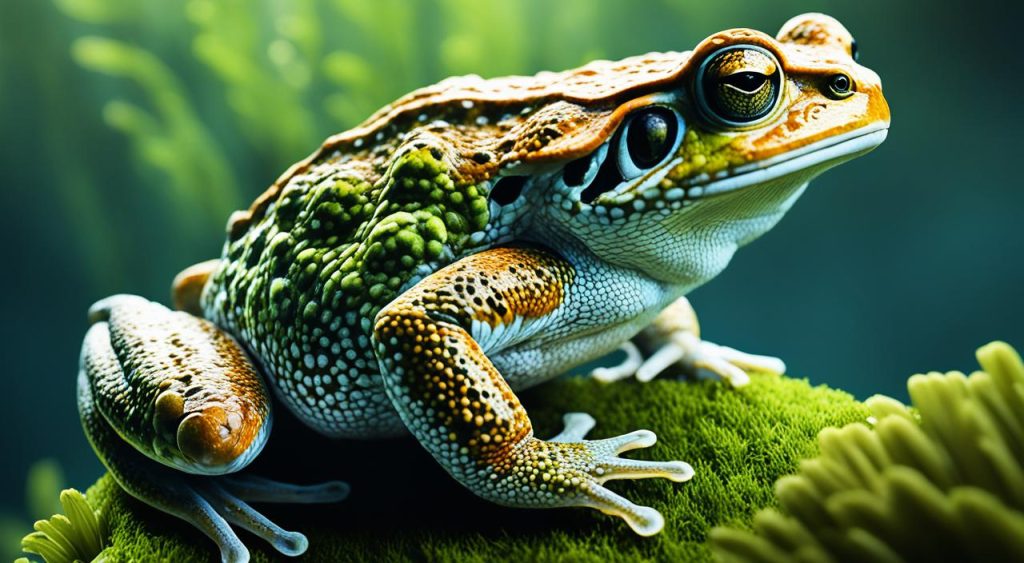
Distinctive Features and Adaptations
Cane toads have large parotoid glands behind their eyes. These glands make toxic secretions to protect against predators. Their skin is rough and warty, providing camouflage and defence.
Webbed feet and strong legs help them swim well. These features also allow them to travel far on land.
Sexual Dimorphism in Cane Toads
Female cane toads are usually larger than males. This size difference is important for breeding. Females can lay up to 32,000 eggs at once.
Their egg strings can stretch up to 20 metres long. Males have rougher skin and make various sounds to attract mates.
| Characteristic | Female | Male |
|---|---|---|
| Average Size | Larger | Smaller |
| Skin Texture | Smoother | Rougher |
| Vocalisation | Limited | Varied |
Cane Toad: A Formidable Invasive Species
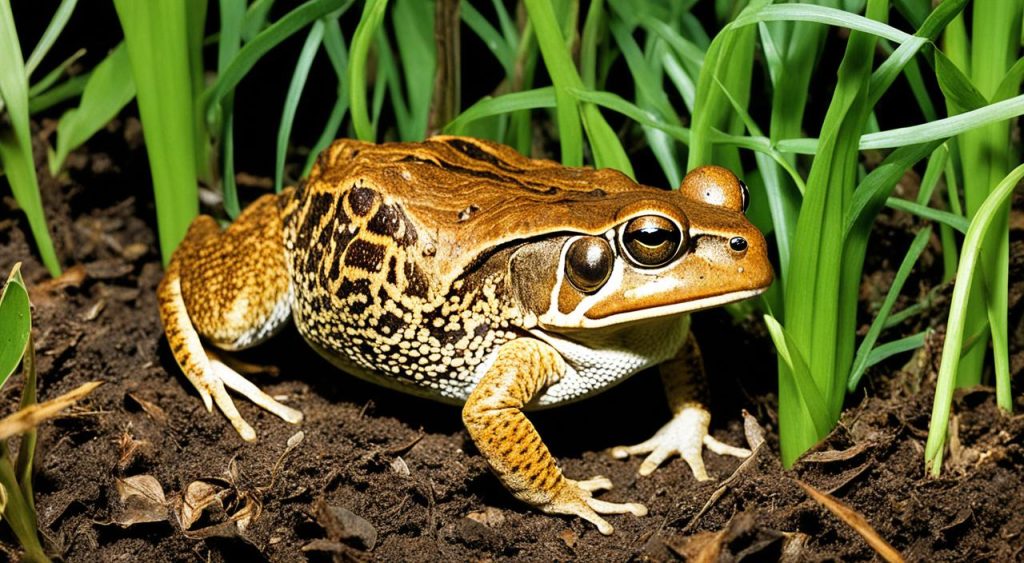
Cane toads are wreaking havoc on Australian wildlife. They’re causing significant habitat destruction since their 1935 introduction to Queensland. These amphibians have spread across tropical and subtropical Australia at an alarming rate.
Cane toads thrive in temperatures from 5°C to 40°C. This resilience helps them colonise diverse ecosystems. Female toads can lay over 30,000 eggs in one clutch.
These toads have devastated native fauna. Their defensive chemicals are lethal to many predators. Lizards, snakes, crocodiles, and marsupials have suffered high mortality rates.
- Cane toads spread at a rate of 50 km per year
- Adult toads typically weigh 200-400 grams
- Tadpoles metamorphose into toadlets within 1-2 months
The invasion has triggered rapid evolutionary changes. Some predators have developed resistance or learned avoidance behaviours. This highlights the complex ecological dynamics in Australia’s ecosystems.
“The cane toad’s invasion of Australia represents one of the most dramatic examples of an invasive species altering entire ecosystems.”
Cane toads continue to expand their range across Australia. Conservation efforts focus on protecting vulnerable species. Developing innovative control methods remains a critical challenge for biodiversity preservation.
Toxic Defence Mechanisms
Cane toads have a powerful defence system. They produce toxic secretions that harm native wildlife. This has helped them thrive as an invasive species in Australia.
Bufotoxin and its effects
Cane toads secrete bufotoxin from glands behind their eyes and skin. This milky-white substance is their main defence. It can cause severe reactions in predators, including rapid heartbeat and convulsions.
In extreme cases, bufotoxin can lead to death. Predators often suffer from excessive salivation when exposed to this toxin.
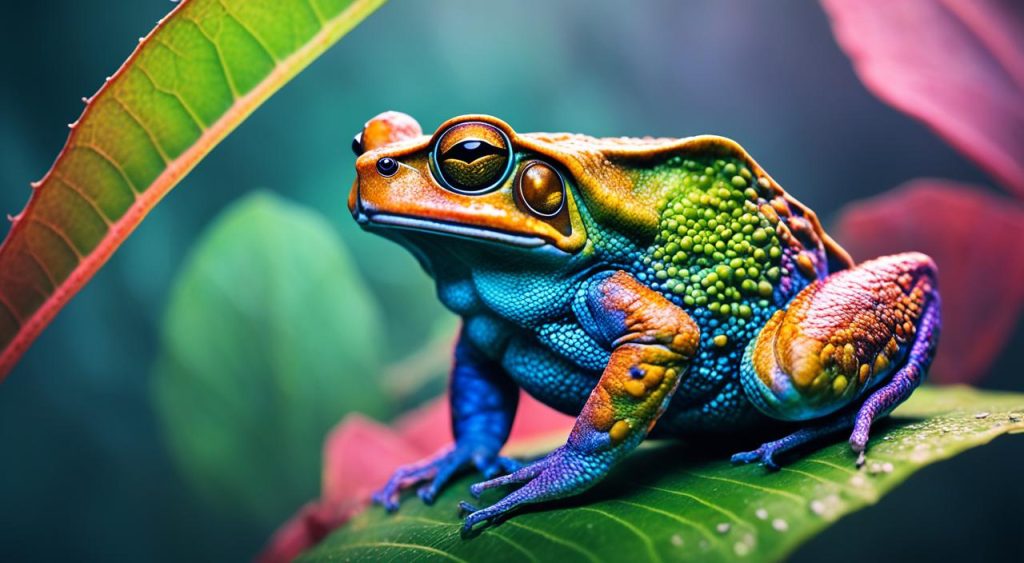
Impact on native Australian wildlife
Cane toads have devastated Australian fauna. Many native predators have faced population declines after eating these toxic amphibians. Large reptiles like goannas and snakes are especially at risk of cane toad poisoning.
Toxicity at different life stages
Cane toads are toxic throughout their life cycle. From eggs to adults, all stages have some level of toxicity. This full-life protection helps them survive and spread across Australia’s diverse ecosystems.
| Life Stage | Toxicity Level | Primary Affected Predators |
|---|---|---|
| Eggs | Low | Fish, aquatic insects |
| Tadpoles | Moderate | Fish, water birds |
| Juveniles | High | Small mammals, reptiles |
| Adults | Very High | Large reptiles, mammals, birds |
Reproduction and Life Cycle
Cane toads are remarkable breeders, reaching sexual maturity in 12 to 24 months. Australian populations mature faster due to ideal conditions. Their reproductive cycle is key to their invasive success.
Breeding begins after the first summer rain, lasting from early spring to autumn. Males gather near water bodies to attract females. This mating ritual starts when water hits 25°C.
Female cane toads can lay up to 35,000 eggs twice yearly. This high fertility rate challenges biological control efforts. Eggs hatch in 1-3 days, releasing tadpoles into the water.
The tadpole stage lasts up to 20 weeks, depending on food supply. Cane toad tadpoles often eat eggs and smaller tadpoles of their own species. This cannibalism helps them survive in resource-limited environments.
Adult cane toads live 5-15 years in the wild, with some living even longer. Their longevity and prolific breeding have led to a population boom across Australia.
“The cane toad’s reproductive success is both impressive and alarming, highlighting the need for innovative biological control strategies to manage their population growth.”
Diet and Feeding Habits
Cane toads are hungry beasts with a varied diet. They eat both plants and animals, which helps them grow fast. This eating habit has a big impact on Australia’s environment.
Omnivorous Nature
Cane toads eat many things. They munch on insects like beetles, bees, ants, and crickets. They also eat small mammals, reptiles, and other frogs.
This wide diet helps them live in many places. They can survive in sand dunes and rainforests. But this causes problems for other animals in these areas.
Impact on Local Ecosystems
Cane toads hurt Australia’s wildlife. They eat food that native animals need. This affects insects like dung beetles, which bees need.
The toads also put some animals in danger. For example, they eat baby rainbow bee-eaters in their nests.
Unusual Food Sources in Urban Areas
In cities, cane toads eat human food scraps and pet food. This helps them live well in towns. A 2016 study looked at why these toads like buildings more than bushland.
| Food Source | Natural Habitat | Urban Environment |
|---|---|---|
| Insects | Beetles, ants, bees | Cockroaches, flies |
| Small Animals | Native frogs, lizards | Mice, small birds |
| Plant Matter | Native vegetation | Garden plants, fallen fruit |
| Other | Carrion | Pet food, human food scraps |
Population Explosion and Spread Across Australia
Cane toads have multiplied rapidly since their 1935 introduction to Australia. Starting with just 101 toads in Far North Queensland, they’ve now caused widespread habitat destruction.
Current Population Estimates
Experts estimate 1.5 billion cane toads now roam Australia. This explosion has led to severe ecological imbalances. Native wildlife and ecosystems face significant threats from this invasion.
Rate of Territorial Expansion
Cane toads are rapidly expanding across Australia. They’re advancing 40 to 60 km yearly, with some covering several kilometers nightly.
The invasion front approaches the Indian Ocean. It has spread through Queensland, coastal New South Wales, and Northern Territory’s Top End. Additionally, 70% of Western Australia’s Kimberley region is affected.
Challenges in Population Control
Controlling cane toads is extremely difficult. They have no known predators in Australia. Their toxic defences have caused declines in native predator species.
Current control methods are limited. These include manual collection, trapping, and euthanasia. No broadscale or biological control agents exist that won’t harm native species.
“The cane toad invasion in Australia is moving at a rate of 50 to 60 kilometers per annum towards the Indian Ocean.”
Conservationists are exploring new strategies to fight this invasion. Taste-aversion training for predators shows promise. A large-scale trial of this approach will soon start in Western Australia.
Environmental Impact and Conservation Efforts
Cane toads have disrupted Australia’s ecosystem since 1935. These toxic amphibians have spread across several states, causing havoc on wildlife. Their invasion has led to significant imbalances in the environment.
Large predators have suffered greatly from cane toad poisoning. Some species have seen population drops of over 80%. The northern quoll, a native marsupial, is at risk of extinction in affected areas.
However, some native species have shown resilience to the invasion. Others have even benefited from the presence of cane toads.
Conservation efforts aim to lessen cane toads’ impact. Taste aversion training for native predators has shown promise. This method exposes animals to non-lethal doses of toad toxin.
The impacts of invasive cane toads in Australia are complex, with indirect effects often outweighing direct impacts.
The National Cane Toad Taskforce is tackling this ecological crisis. Their strategies include:
- Implementing short-term local threat abatement strategies
- Researching Bufo-specific pathogens
- Exploring biological control methods
- Developing cane toad specific toxins
The cane toad continues to spread across Australia. Ongoing research and community involvement are vital. These efforts help preserve unique ecosystems and protect native wildlife from this invasive species.
Unique Uses and Cultural Significance
Cane toads, brought to Australia for pest control, have left a lasting impact. They’ve inspired creativity and research, leading to unexpected uses and cultural trends.
Indigenous Uses
Cane toads held importance in some indigenous cultures before reaching Australia. South American tribes used toad toxins for hunting. They applied the poison to arrowheads to catch prey more easily.
Modern Research and Applications
Scientists now study potential benefits of cane toad toxins. The University of Queensland is exploring bufotoxin for cancer treatment. This shows how our view of invasive species can change over time.
Toad-Inspired Art and Culture
Cane toads have become surprising inspirations in Australian art and literature. The film “Cane Toads: An Unnatural History” (1988) is a top-grossing Australian documentary.
Author Morris Gleitzman created a series starring Limpy, a cane toad character. His books include titles like “Toad Rage” and “Toad Heaven”.
Even fashion has embraced the toad’s influence. Unique cane toad leather products have emerged. These items show Australians’ ability to find humour in ecological challenges.
These cultural responses reflect mixed feelings about this failed pest control experiment. The cane toad has become an unlikely national icon in Australia.
Future Outlook for Cane Toad Management in Australia
Cane toads have a firm hold on Australia’s ecosystems. They currently inhabit about 1.2 million km2 of land. Models predict a potential expansion to 2.0 million km2, nearly tripling earlier estimates.
This rapid spread challenges pest control efforts. It also highlights the growing environmental impact on Australian wildlife. Researchers are exploring innovative management strategies to combat this issue.
Taste aversion training for native predators shows promise. It could help protect vulnerable species from cane toad toxins. Scientists are also studying potential medical uses of these toxins.
Urban environments seem to be changing cane toad features. Studies in north Queensland reveal smaller poison glands in urban toads. This quick adaptation has occurred within 85 years of their introduction.
Urbanisation may shape future cane toad populations. It could also affect their impact on local ecosystems. Complete eradication of cane toads is unlikely.
Ongoing research and public education are vital. Understanding the cane toad’s adaptability is crucial. Implementing targeted control measures can help minimise their long-term impact on Australia’s unique wildlife.
FAQ
What is a cane toad?
Cane toads are large amphibians from South and Central America. They were brought to Australia in 1935 from Hawaii. Their purpose was to control cane beetles in sugar cane fields.
Why are cane toads considered an invasive species in Australia?
Cane toads have become a major problem in Australia. They cause local extinctions of native animals. With about 200 million toads, they spread across northern Australia at 50km per year.
What makes cane toads toxic?
Cane toads make a toxic substance called bufotoxin. It’s found in their parotoid glands and skin. This toxin can harm or kill native animals and pets that try to eat them.
How do cane toads reproduce?
Male cane toads call for mates after the first summer storm. Females lay up to 36,000 eggs twice a year. Tadpoles hatch within 1-3 days.
The tadpole stage lasts up to 20 weeks before they become adults.
What do cane toads eat?
Cane toads eat almost anything they can swallow. Their diet includes insects, pet food, and household scraps. This varied diet helps them thrive in new environments.
How are conservation efforts protecting native species from cane toads?
One method is taste aversion training for native predators. This uses cane toad sausages and small toads. It exposes predators to non-lethal doses of toxin.
This approach has shown success in some parts of the Kimberley region.
Are there any unique applications of cane toads?
Choco Indians once used cane toad poison on arrowheads. Today, cane toad leather is used for unique products. Researchers are exploring medical uses of cane toad toxin, especially for cancer treatment.
